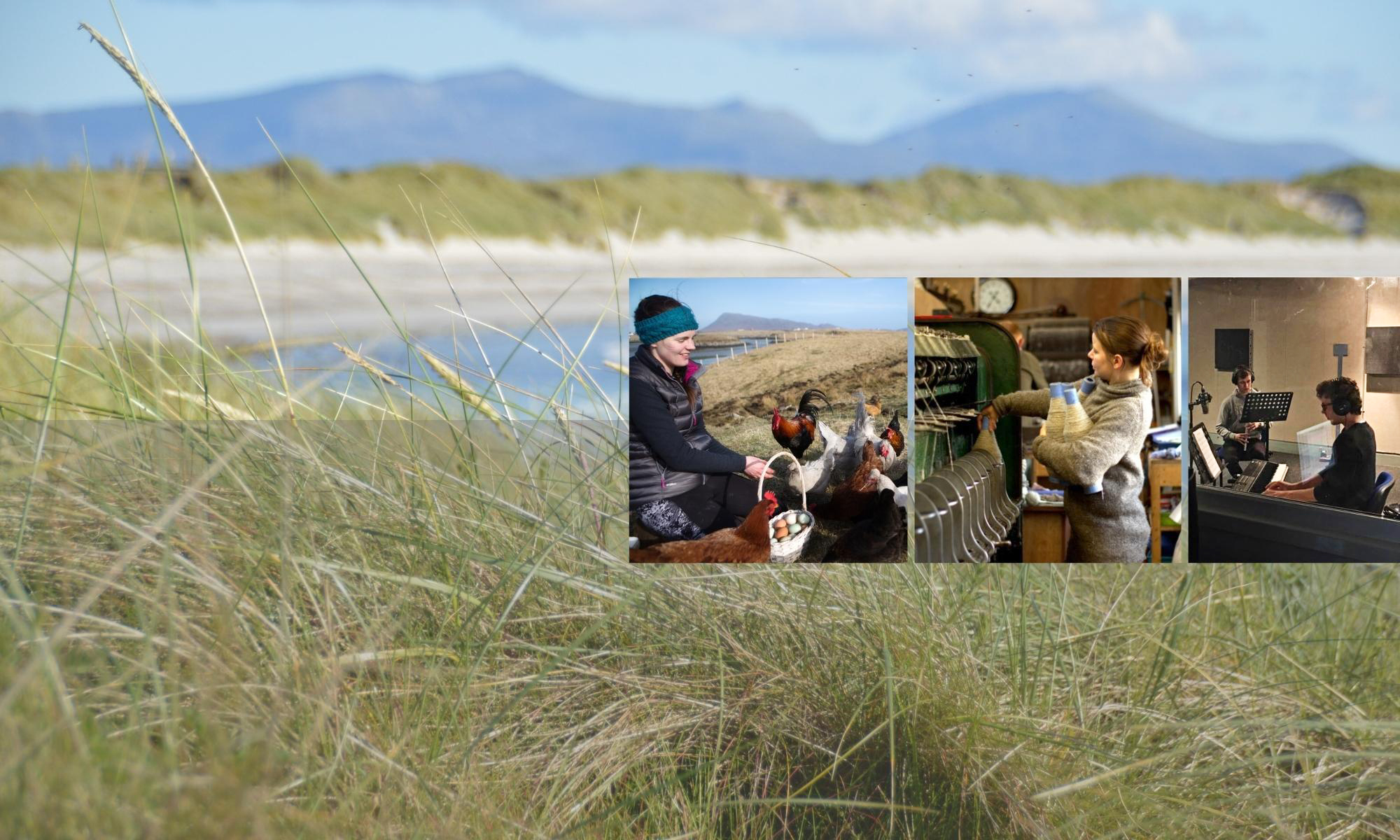The common perception is that island populations are in decline and that lack of jobs is the key driver behind such decline. On the other hand, surveys reveal that the Highlands and Islands are the best place in Scotland to live and more young people want to stay or settle there, while many island jobs remain unfilled. So what do we make of these apparent contradictions?
The population of the Highlands and Islands has been declining for a very long time, and the population projections for remote and sparsely populated areas in Scotland forecast a bleak future: a decline of 25% in total population and one-third in the working age population by 2046 (see the James Hutton Institute’s SEFARI casestudy that underpins the Islands Revival blog). Yet, as the SEFARI casestudy suggests, the future projections are based on past trends, and will prove wrong if we are in a transition phase when past trends are changing.
The Islands Revival blog provides examples of islands that have reversed population decline. For example, the populations of Eigg and Westray, in Ulva Ferry on Mull (see here and here) and on West Harris (forthcoming blog post) are increasing, and in some cases dramatically so.
The Islands Revival project was partly set up to determine whether micro-trends within island populations were being hidden within more macro-level data, whether positive changes on individual islands were not being captured within more aggregated data. In each of these examples there may be specific reasons for the turnaround in their populations (see the individual blog posts).
It is also possible that larger macro-level changes are beginning to impact island populations. According to the latest Bank of Scotland happiness index, “people living in the Highlands and Islands are now the happiest in Scotland”, “with the natural environment and sense of community credited with helping to boost residents’ cheerfulness”. And HIE research on young people’s attitudes in 2015 and 2018 concluded: “Since 2015, an increasing number of young people want to live and work in the Highlands and Islands. Almost half (46%) of survey respondents [in 2018] identified themselves as committed stayers, versus 36% previously.”
There is some concrete evidence to suggest that this shift in attitudes is having a real impact on the ground. We have found evidence of significant numbers of young people (from leaving school to in their 30s) returning, settling or staying on Uist (see CoDeL’s first report). We believe this is a part of a global shift in aspirations among young people who no longer automatically migrate to cities to be connected to economic, social and cultural opportunities, but are choosing the far higher levels of well-being that they can often achieve in rural areas, and at a fraction of the cost of living in a city (see CoDeL’s post on the Islands Revival blog).
A key indicator of a decline of young adults within the population is the number of children on the islands. School rolls in the Outer Hebrides continue to decline, but this is only because of the continuing decline in secondary school pupils. Primary school rolls have been quite steady since the last census in March 2011. At that time (the school year 2010-11) there were 1870 primary pupils in the Outer Hebrides. In 2018-19 there were 1875. There have been significant declines in secondary school enrolments (-15% since 2010-11), but this also seems to be leveling off. The figures for S2 enrolment show a decline of only 6% since 2010-11, and for S1 a decline of only 2%.
A likely interpretation of this data is that the population decline among child-rearing adults (a key demographic group) is leveling off. The number of children on the islands, at least pre-teens, has stabilised – is no longer in decline – and any out-migration of families is balanced by in-migration of new families. This leveling off still has to work its way fully through the secondary school rolls.
And so we come to the critical issue of jobs. Any island resident will know how common it is for islanders to say that there are no jobs to attract or keep young people and others on the islands, and surveys have repeatedly found that creating jobs is among the highest priority for islanders. The primary argument for any investments on islands is the number of jobs the projects will generate, and this applies particularly to larger scale publicly supported investments.
On the other hand, the reality in the Outer Hebrides, for example, is that there are many island jobs that are vacant because island institutions and organisations cannot recruit people for them.
For example, there have long been around 110/120 vacancies in health and social care across the whole of the Outer Hebrides, across all parts of that sector, for example among GPs, Allied Health Professionals and Social Care.
Elsewhere in the public sector, Comhairle nan Eilean Siar (the local authority) has a policy that if a teaching post has been advertised a number of times and failed to recruit, the council can offer a number of financial incentives, and has offered to retrain graduates in the council to become teachers to fill gaps.
The aquaculture sector is critical for the Uist economy and comprises companies like Mowi (formerly Marine Harvest), the Scottish Salmon Company and Loch Duart. All these companies struggle to recruit, with Loch Duart paying for driving lessons to recruit and retain young workers after their initial training period. Calmac have an ageing workforce and Uist Asco (which processes seaweed) wants to recruit more seaweed gatherers. These kind of jobs all need skills such as small boat handling and health and safety at sea, which is why the local authority worked to get a new National Progression Award in Maritime Skills in schools which includes industry standard qualifications for the sector, approved by the Scottish Qualifications Authority (SQA).
And similar recruitment challenges confront other critical sectors like hospitality and childcare. And within the dynamic Third Sector (see here), such as charities and social enterprises, the field of potential recruits is often small.
Even within the Gaelic sector on Uist, which is regarded by many as the heartland of the language, organisations have recruited some international workers into graduate level jobs. They have made fantastic contributions to the local island communities, but it tells its own story when the islands recruit from so far outwith their own community. Indeed, within the Gaelic sector across Scotland, whether education, media or other organisations, competition for recruits is intense.
So it appears that on Uist and the Outer Hebrides more generally there are plenty of jobs that cannot be filled because of the lack of recruits.
Potential supporting evidence for this comes from the Comhairle’s latest Socio Economic Update (No 40, May 2019):
-
The employment rate in the Outer Hebrides was 79% from January to December 2018 compared to 74.1% for Scotland and 75.1% for Great Britain.
-
Self employment in the islands has risen by 1.8 percentage points to 12.4% compared to 8.4% in Scotland and 10.6% in Great Britain.
-
The Job Seeker Allowance claimant rates in April 2019 were 2.1% for the Outer Hebrides, compared to 3.1% for Scotland and 2.8% for Great Britain.
-
The Outer Hebrides had the highest employment rate for young people aged 16-24 years at 72.9%. In the Outer Hebrides it has increased by 9.9 percentage points from 63% in 2008.
On some of these parameters there has been a deterioration since last year (see the details in the CnES Update), and on almost all the indicators Orkney and Shetland outperform the Outer Hebrides. Nevertheless, the figures for the Outer Hebrides remain striking in comparison to Scotland as a whole.
So, while no islander would say we don’t need more jobs that could attract more economically active people to stay, return or settle on the islands, jobs are clearly not the only factor, and may not even be the key factor anymore, in determining population trends. Small island economies can face market failures in terms of a mismatch between local jobs on the one hand and the skills and/or desired employment patterns within the island population on the other. The key policy solution here is clearly to match the skills and conditions of jobs currently vacant with the skills and aspirations of potential recruits.
And, clearly, other constraints are coming into play, which are preventing people moving to the islands to take up the jobs available. Without any doubt, the lack of suitable, diverse and affordable housing is very high among these constraints (see here, here and here). The 2011 census recorded the first increase in population on Westray for 110 years. However, the thriving community with its expanding employment and economic opportunities cannot attract more people without increased housing provision (see here).
It is also clear that attitudes among young people are changing, relating to the desirability of a good location and the related well-being that comes with it, to the kind of careers they want to develop, and to the importance of identity and culture (see here and here). These changing attitudes make up perhaps the most important and indeed most hopeful new trend that is impacting island populations. Any new developments and investments clearly need to nurture and grow this trend for the islands, and not undermine it in any way that could turn young people away from staying or coming to the islands.

